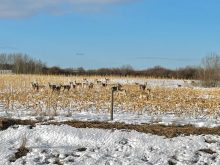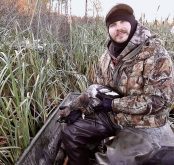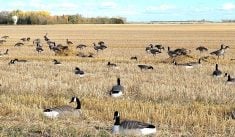Manitoba’s elk producers aren’t surprised that the province has seen its first case of chronic wasting disease (CWD).
With an increasing population of mule deer spreading east from Saskatchewan, they say it was bound to happen.
The province announced Manitoba’s first CWD case Nov. 1, found in a visibly sick male mule deer euthanized near Lake of the Prairies in mid-October.
Why it matters: While CWD testing is already in place in the industry, farmers say the finding may put a crimp in the plans of some farms hoping to export live animals to some areas.
Read Also

Seeding Indigenous agricultural prosperity
National Circle for Indigenous Agriculture and Food says Indigenous agricultural success needs strong relationships.
The province moved to institute a temporary hunting ban of all cervids (including white-tailed deer, moose and elk) in the area, worried that other animals may also be carrying the illness.
“We don’t want carcasses leaving the zone for a period of time, at least at the initial stages while we’re trying to assess the situation,” Rob Olson, director of the province’s wildlife, fisheries and resource enforcement branch, said.
The ban spans from Provincial Road 482 south of Asessippi Provincial Park to Roblin, and east to west from Highway 83 to the Saskatchewan border.
Olson says the province will be stepping up testing efforts targeting mule deer, both in the region where the CWD case was confirmed and in other regions of the province.
The situation is evolving quickly, he also noted.
“This is a thing where we’re really going to honestly need the help of people out there,” he said, urging anyone to contact their local conservation officer if they see any cervid, “acting odd, not looking healthy or normal, emaciated, unsteady on its feet, drooping head, drooling, just an animal not looking right.”
Scope of issue
CWD is a death sentence for cervids like deer, elk and moose, with progressive neural degeneration leading to symptoms like weight loss, unusual behaviour, lack of co-ordination, excessive saliva and urination or paralysis.
But while testing for CWD has been a longtime standard for farmed cervids up for slaughter in Manitoba — as well as cervids hunted in the CWD surveillance zone along the western strip of the province — there has never before been a case of the deadly disease in either farmed or wild populations. Canadian issues with CWD have, until now, largely been isolated to provinces such as Alberta and Saskatchewan.
In 2020-21, Saskatchewan’s provincial CWD hunter surveillance program found 466 cases of the disease, 338 of which were found in mule deer. Cases were largely in the western part of the province.
Eight domestic elk or deer herds have also had CWD cases confirmed this year, according to the Canadian Food Inspection Agency. Of those, five were in Saskatchewan and three in Alberta.
As of Nov. 5, CWD had not been detected in any domestic cervid herd in Manitoba.
Ian Thorleifson, president of the Manitoba Elk Growers Association, said the wild CWD finding will, so far, change little for their producers.
“It’s not devastating for us because we’ve been anticipating it,” he said, noting that elk farmers already faced the same limitations as producers in provinces with a history of the disease.
“As elk farmers, we’ve already been implementing strict biosecurity measures to prevent the disease coming onto our farms,” he added.
Feed is, by far, the largest disease vector of concern, he noted, since wild cervids trample, eat and bring saliva, urine and feces in contact with crops left in the swath.
Where the news might hit harder is in the export of live animals to certain U.S. states, which require farms be a certain distance from any CWD finding. Some of those states are big destinations for elk producers exporting bulls for trophy harvest, according to Thorleifson.
“They’re a big part of our industry,” he said.
He linked the issue with the association’s desire to see on-farm trophy harvest OK’d in Manitoba.
There are farms in the affected area, Thorleifson noted, although it is unclear whether those farms are in the business of exporting live animals.
As well as the post-mortem test, Thorleifson noted that the industry also has its eye on a “quite accurate” live test, which would allow farmers to screen their herd and, if there is a possible infection, remove that animal before the illness spreads.
Call for control
Elk producers had previously called for control of the mule deer population, given the species’ susceptibility to CWD.
In 2019, the producers’ group reported that it had met with the province on the issue.
The issue is “an urgent conversation,” Olson said, adding that the province has heard from CWD scientists as well as the producers’ group, and is currently consulting with subject matter experts.
“It’s been something that we’ve been considering seriously for the last, I’d say, couple of years,” he said.
Thorleifson said the association has been urging the province, “for years to put more pressure on the mule deer population in Manitoba.”
Mule deer range has expanded “all the way from Swan River right down to Melita, and we knew, eventually, there was going to be an infected deer walking into the province,” he said.
“It’s true that mule deer are more susceptible than the other cervids, there’s no doubt about that,” Olson said. “To this point, before the positive finding, they are an endangered species in the province, recognized under provincial legislation. But, by the same token, the disease threat is significant and important and so we’re looking at that now, for sure.”
Mule deer are currently classified as a threatened species and are illegal to hunt in Manitoba, except by Indigenous hunters.
















